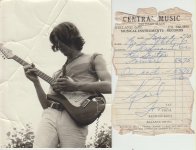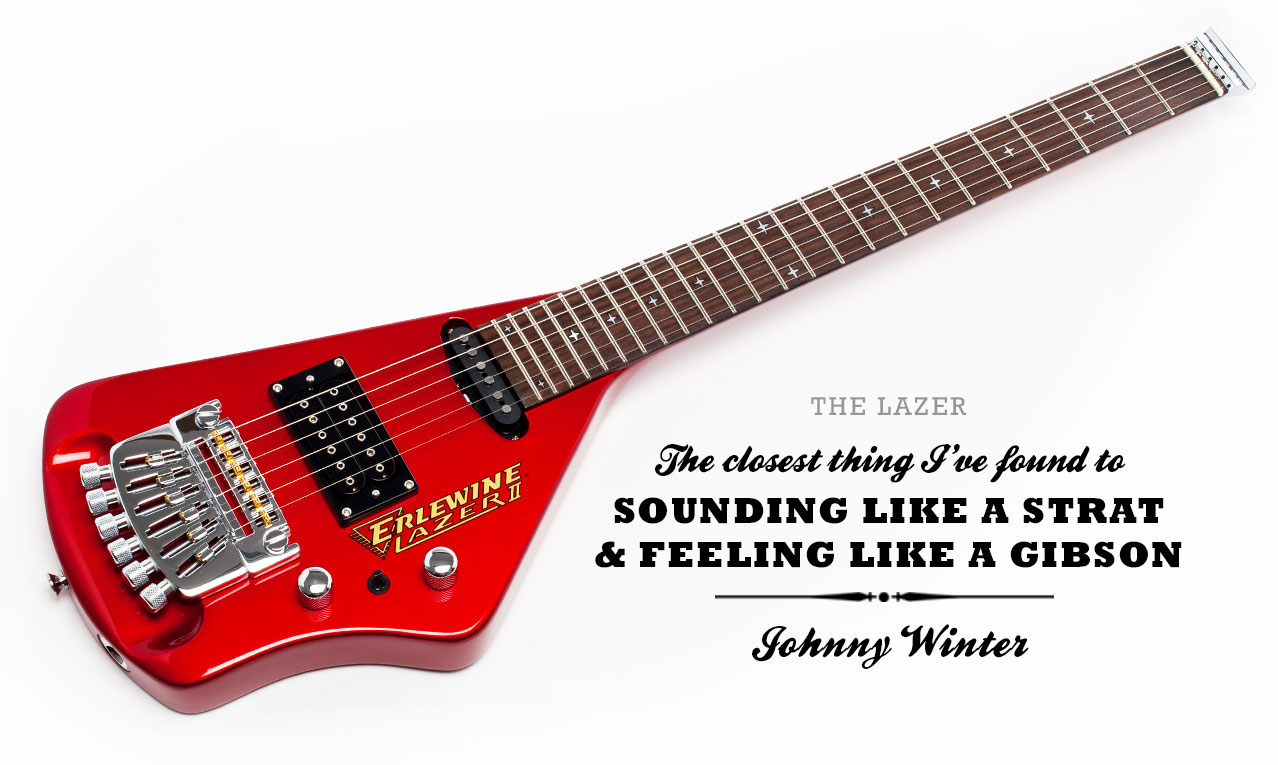The Fender Stratocaster tremolo arm, a handle to a new world of sound.
Leo Fender invented the Stratocaster to be a stand-up steel guitar.
He designed the tremolo so you could lower pitch, and come back,
or start lowered, and come back up, detuning effects.
That's'a flatterussgo to repitchigo, hopefully, with no al dente, or sticking.
I see it as the most complicated part of any musical instrument ever made.
The Stratocaster featured, for the first time in our human history,
two way bridges for each string, lengthening and raising or lowering.
That allowed you to tune, not tempered tuning, but scientific tuning,
using an oscilloscope, what Jimi learned doing radar in the Air Force.
You could use volume feedback, or battery driven amplifier effects, and control them.
That's making sounds, or coping with what is happening even if you didn't make them.
At the very least, if you started feeding back uncontrollably,
you could detune the guitar to lower the feedback, or stop it.
That's playing guitar with the tremolo arm in your hand, using a lot of feel.
You had to set up your guitar by adjusting the five springs inside,
so you had that feel, and detuned as low as you wanted to go.
Using all five springs, four or three, was a flaming debate back then.
Leaving the spring cover off to get sounds by touching the springs,
was also debated, was it really playing your guitar?
Or, was your guitar playing you? It works both ways.
Some guitarists just used it for wild effects, calling it a whammy bar,
like Ritchie Blackmore, the second musician in history to use a Strat and Marshall,
just no effects, advertised as playing straight into the amplifier.
He first used an effect five albums in, the intro to "Stormbringer", a Dr. Q.
That was an Electro-Harmonix effect to simulate a wah-wah.
When Jimi passed away, Jeff Beck came out with a Strat and Marshall,
again, advertised as playing straight through to the amplifier.
This photo, with the receipt from when I made my final payment for my 1964 Stratocaster,
shows that I don't have the tremolo arm on, having a hard time with it,
not being reliable.
I'm using a 50 watt Marshall with the slanted, eight ten-inch speakers,
with a Crybaby wah-wah, a Small Stone phase shifter, and a Dallas Arbiter fuzz-distortion,
some of the same equipment Jimi used when I saw him in Toronto.
The Marshall was ordered direct from England before there was a franchise in Ontario.
Some people, only because so many are now gone,
say that I'm one of three musicians in Ontario, maybe Canada,
to be playing with the same equipment Jimi Hendrix used, while he was alive.
I know I was. I still remember, a life-long non-smoker, non-drinker, not even tea or coffee.
It is so nice to be so acutely aware of the instantaneous changes in sound,
all this electronic equipment can generate, louder than an entire symphony.
Just like sax players wear their reed around their neck,
Strat players would keep their tremolo arm on them,
because if someone made off with it, you felt you really couldn't play.
I can understand Johnny Winter not getting into, what was then, something totally new.
He used an electric guitar, to be loud for sure, but he was more about the tone.
His tone. Not just making a lot of sounds you could E.Q. and dub together in the studio.
Again in Texas, Jimi gave Billy Gibbons a Strat and Marshall so he had a chance onstage,
as his opening act.
That made Z.Z.Top into one of the biggest touring bands ever.
You either let the tremolo arm hang from your little finger,
and use it sometimes as a vibrato effect,
or you were palming it all the way, deep into the feedback, a new tone zone.
I'd love to get into the combination of tremolo with various levels of pick-guard,
aluminum plate lining, exposures to the volumes of the speakers,
with considerations of 15' or 25' double-grounded cord length, even curly cords,
but that can only be described as environmental to the actuality of only playing,
nothing you can describe until it's gone, and the air around you does feel sad,
without all those deep tones and movements of sound,
while even the.. wind.. cries.. Mary.. juana, or you don't wanna.
It's one of those spring things for me, and I'm still extending them.
Jimi had a groove, waist high, carved into the side of his Marshall stack,
so he could, uh, rest the tremolo arm as the amplifier held it,
and take away his arms to move them around, while he used his hips to move it,
getting the sounds and tones of his only smash hit albums,
while, as they say, he made love to his amplifier. That's very satisfying.
Especially when it's the big bucks getting thrown at you backstage.
This comment is for JHC. Feedback is an after-effect, a following up,
especially if you are using echo with reverb. That's spring reverb.
Fender had two little springs for reverb, a Hammond organ had three bigger ones.
I had a Hammond reverb custom built into an incredible amplifier,
custom ordered from Scotland, the Redmere Soloist.
I could have deep reverb and kick the amp, and it sounded like low, rolling thunder,
or with heavy volume and distortion, with phasing to add that 9-volt battery juice,
start by rubbing my finger lightly over the bridge, to moving it up the strings hard,
to sound exactly like a steam locomotive coming through the wall at you.
Some bars limited me to doing that only once a night,
because customers would spill drinks or think their train was a'comin'.
"Can you hear your train a'comin', yes I can hear my train a'comin'."
Lyrics to a song by Jimi Hendrix.
Anything Jimi Hendrix played, me too, can be played at a conversational level.
Drowning out your audience, is a hazardous watt age, massive turbo-generator result.
Even the armatures at Niagara Falls remember the night Jimi played in Toronto.
They too, thought that all rock concerts were going to sound like that,
but no-one ever did, speakers in all four corners and sides of the arena,
stereo miking before there was stereo equipment, stereo roadies panning,
while never taking their eyes offa Jimi Hendrix and his waving, watted up, '64 Stratocaster.
Just like I've ever only used an electric shaver,
I've never played an acoustic up on any professional stage.
I still get lost in the sounds around me,
and where they go, oh yeah, nobody knows, except now, maybe Jimi,
but he wasn't known for sticking around.
What "sheet of sound" is playing now?
"The Very Best of John Coltrane", a 2000 Rhino Entertainment Company product,
a CD, as new, with the booklet, $1.
Music can engender just like birds of a feather. This is at the end of the booklet.
"Move The Money. Military spending is still at Cold War levels,
TRIPLE the federal support for education, job training, crime prevention,
and environmental protection COMBINED.
You can help move the money to where it belongs".
Jimi: "When the power of love is greater than the love of power, there will be peace".
May All Peace Be Upon Us, or, PULL THAT PLUG!!! PULL THAT PLUG!!!! whew....
That Central Music phone number is still good, now starting with a 905.


